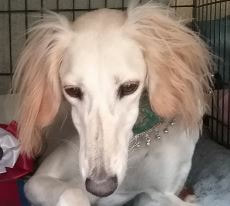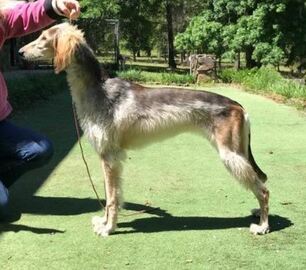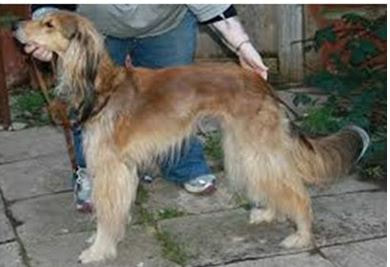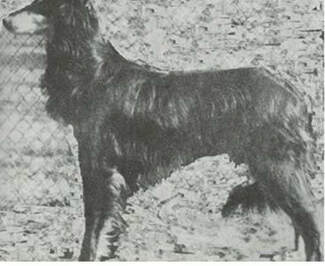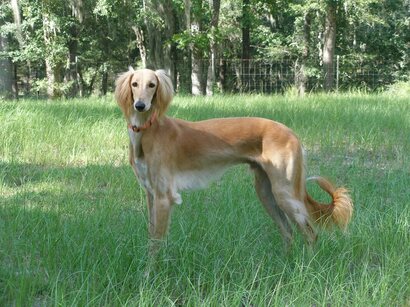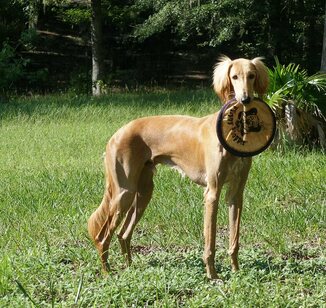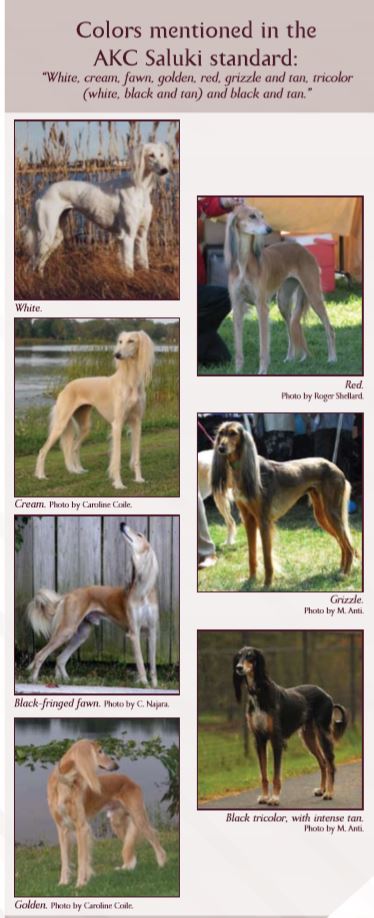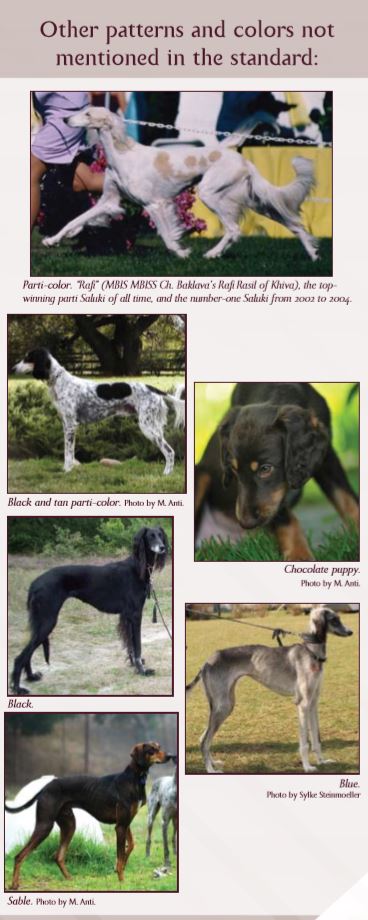Coat and Color
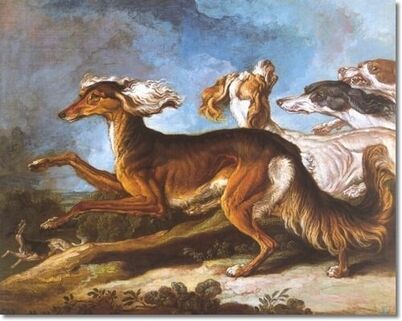
COAT: From the AKC Standard: Smooth and of a soft silky texture, slight feather on the legs, feather at the back of the thighs and sometimes with slight woolly feather on the thigh and shoulder.
Tail: ... well feathered on the underside with long silky hair, not bushy
Ears: ... covered with long silky hair
Feet: ...well feathered between the toes.
The Smooth Variety: In this variety the points should be the same with the exception of the coat, which has no feathering.
This all seems very straight forward but as always, there are some less clear points. 1) Does length matter? 2) What about long or fuzzy body coats on puppies and neutered vets? 3) What about a neck ruff? 4) What does a bushy tail look like? 5) Can a smooth have a slight brush tail? 6) Why do smooths seem to have a different body type? 7) How does color affect coat?
1) Does Length Matter? Several years ago the SCOA sent a notice to all AKC judges stating that length of feathering didn't matter and should be ignored. While I understand the intent (I hope) I disagree with the wording. As written, the letter directs judges to disregard parts of the AKC standard that twice call for "long silky hair (ears, tail) and twice call for "well feathered" (tail, between toes) in feathereds. While what constitutes "long" and "well-feathered" may be a matter of personal opinion, it is surely not the same as 'short" and "sparsely feathered." So I disagree that length doesn't matter because the standard clearly states it does. What I DO agree with is that 8 inch feathering is no better than 2 inch feathering when evaluating dogs. I believe (hope) what they meant to say is that length doesn't matter as long as it first fulfills the standard's requirement of "long" or "well-feathered." Great length should neither be rewarded nor penalized.
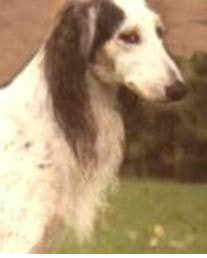 Neck ruff
Neck ruff
4) Bushy tail. The standard specifies that the tail is not to be "bushy." Chances are you will never see a bushy tail. A bushy tail is one that has thick hair growing from not only the underside but the top, like a Borzoi's. Creams have a tendency to have bushier tails than other colors but even then I have seen very few, if any, that would cross the threshold into being actually bushy.
5) Brush tails on smooths. The coat on smooths is genetically short haired, and like many short haired dogs they can have a slight brush on their tails. Smart handlers groom it off. Generally such a brush would not be considered a fault.
6) Certain colors are loosely associated with coat length. Creams, for example, tend to have heavy tail feathering whereas black & tans have the most sparse tails. Creams historically had the shortest ears bit that has changed. Black & tans tend to have the heaviest ear feather. None of these are firm rules.
SMOOTH Variety: The smooth coat is caused by a single dominant allele. Some smooths will have a slight brush, which should not be faulted. Many people believe smooths are more muscular, but that appearance is because they lack the undercoat and longer guard hairs of most feathered, so have a more sculpted buff look. If you wet down a feathered dog it too will look more muscular (see the same dog dry on the left and a few minutes later wet on the right below).
Smooths and feathered should be judged on an equal basis. As breeders, we really don't care about coat type. You shouldn't either.
COLOR
AKC Standard: White, cream, fawn, golden, red, grizzle and tan, tricolor (white, black and tan) and black and tan.
In recent years color has become controversial. Our standard has some notable omissions: chocolate color and parti-color pattern. Yet both are considered perfectly acceptable and should be. But when brindles appeared fairly recently there has been considerable disagreement over whether they are historically correct and whether the standard excludes them. See "The Brouhaha About Brindle" for an in depth discussion. My feeling is that no, brindles are probably not "purebred" in the sense of Western breeding. However the time to have caught this was when they first appeared, and their non-brindle littermates would be just as non-pure. It is not the judge's responsibility to decide lineage or purity of an exhibit. Do brindles adhere to the standard? If you wish to exclude brindles then you would have to exclude chocolates, parti-colors, pure blacks and blues, or even any grizzle without tan. The FCI does consider brindle as "undesirable" in their standard, but in North America we use the AKC standard. It is unlikely the AKC standard will be changed to clarify the situation as the membership is unable to agree and is also reluctant to open the standard for any reason. Note: Breeder judges are about evenly split as to whether brindles should be accepted in the ring. The above is my opinion and not universally held.
Other "rare" colors are not controversial. Pure blacks (without tan pips) are not commonplace in North America but are seen occasionally elsewhere. Blues, which are a sort of agouti blue (in fact they appear to be dominant black modified by the "grizzle" gene) are probably akin to blue in Afghans, and associated with recent Iranian imports.
A word about chocolates (livers: b/b): These dogs will have lighter nose and eye pigment. When combined with the tan point or the grizzle patterns a chocolate saluki is obvious. It is less obvious on a sable, in which the normally black ear fringes will be brown, and especially in a cream, in which the dog will have a very light nose and eyes but no other clue that this coloration isn't due to bad pigment but to phantom chocolate. You will not see a lot of chocolate salukis, and you will very rarely see cream chocolates. Light or pink noses in cream salukis is usually due to poor pigment, not hidden chocolate.
And a word about creams and sables. We have at least two genetically distinct types of creams, golds and reds. The first, caused by the ch/ch allele, is born light and gets slightly darker with age. They have white vibrissa, and may tend to have fading pigment with age. The second, caused by the Sable allele, is born dark and gradually lightens. Most retain dark ears fringe tips and are called black-fringed reds or fawns, but some continue to lose that black fringe and can be indistinguishable from clear creams and reds--except that they have black vibrissa and never get faded nose pigment. As a judge, it won't matter to you unless for some odd reason you get to a point where your choice is to go against the white vibrissa cream with the slightly lighter nose pigment in favor of the black vibrissa cream with dark nose pigment. That would really not be fair!
No color should be favored in the ring. Creams have been the fad for the past two decades, but color is immaterial.
Outside Links:
Saluki Colors and Patterns (photos)
Saluki Colors and Patterns (drawings)
